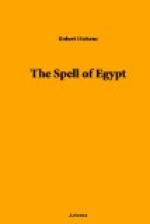there traces, and nearer, to the right, Rameses III.
had made a temple, surely for the birds, so fond they
are of it, so pertinaciously they haunt it. Rameses
II., mutilated and immense, stood on guard before
the terrific hall of Seti I.; and between him and
my platform in the air rose the solitary lotus column
that prepares you for the wonder of Seti’s hall,
which otherwise might almost overwhelm you—unless
you are a Scotch lady in a helmet. And Khuns
had his temple here by the Sphinx of the twelfth Rameses,
and Ptah, who created “the sun egg and the moon
egg,” and who was said—only said,
alas!—to have established on earth the “everlasting
justice,” had his, and still their stones receive
the silver moon-rays and wake the wonder of men.
Thothmes III., Thothmes I., Shishak, who smote the
kneeling prisoners and vanquished Jeroboam, Medamut
and Mut, Amenhotep I., and Amenhotep II.—all
have left their records or been celebrated at Karnak.
Purposely I mingled them in my mind—did
not attempt to put them in their proper order, or
even to disentangle gods and goddesses from conquerors
and kings. In the warm and seductive night Khuns
whispered to me: “As long ago at Bekhten
I exorcised the demon from the suffering Princess,
so now I exorcise from these ruins all spirits but
my own. To-night these ruins shall suggest nothing
but majesty, tranquillity, and beauty. Their
records are for Ra, and must be studied by his rays.
In mine they shall speak not to the intellectual, but
only to the emotions and the soul.”
And presently I went down, and yielding a complete
and happy obedience to Khuns, I wandered along through
the stupendous vestiges of past eras, dead ambitions,
vanished glory, and long-outworn belief, and I ignored
eras, ambitions, glory, and belief, and thought only
of form, and height, of the miracle of blackness against
silver, and of the pathos of statues whose ever-open
eyes at night, when one is near them, suggest the
working of some evil spell, perpetual watchfulness,
combined with eternal inactivity, the unslumbering
mind caged in the body that is paralysed.
There is a temple at Karnak that I love, and I scarcely
know why I care for it so much. It is on the
right of the solitary lotus column before you come
to the terrific hall of Seti. Some people pass
it by, having but little time, and being hypnotized,
it seems, by the more astounding ruin that lies beyond
it. And perhaps it would be well, on a first
visit, to enter it last; to let its influence be the
final one to rest upon your spirit. This is the
temple of Rameses III., a brown place of calm and
retirement, an ineffable place of peace. Yes,
though the birds love it and fill it often with their
voices, it is a sanctuary of peace. Upon the
floor the soft sand lies, placing silence beneath your
footsteps. The pale brown of walls and columns,
almost yellow in the sunshine, is delicate and soothing,
and inclines the heart to calm. Delicious, suggestive




